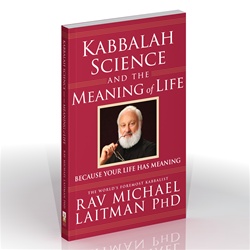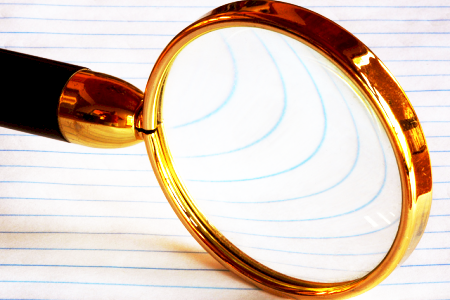Acquiring the Tools to Perceive Spirituality
From birth, we have the tools to perceive the physical reality. Within these tools are “information bits” about the states and shapes that we are destined to realize—the Reshimot. Through education and environmental influence our tools evolve until we have “normal” perception of the physical reality.
However, this is not the case concerning the perception of the spiritual reality. We have no “standard” by which to test if we are building our inner vessels correctly to disclose the attribute of bestowal and the discovery of the spiritual reality.
We do not know what to do with our desires, how we should shape them, and with which intentions we should prepare them. To assist us in this task, Kabbalists provide us with the necessary definitions. They teach us how we can calibrate our tools of perception to perceive the spiritual reality.
We perceive the physical reality in a predetermined manner; we were born and raised without being asked our opinions in the matter. The physical perception patterns that were formed in us while maturing make us sense the Light of Ein Sof. This Light actually stands opposite us all the time—the physical reality within which we and the world around us exist.
Yet, nothing is preordained as far as the spiritual reality is concerned. We must find our own ways of perceiving spirituality, and only the tools that we will build will provide each of us understanding about the Creator, the Upper Force that builds and influences everything.
We should keep in mind that reality is built within us. Our inner qualities reflect a “shadow” upon the abstract Light, thus creating our world pictures, the spiritual as well as the physical. Thus, the way we will perceive the Creator depends solely on our own qualities.
The Scientific Evolution of How We Perceive Reality
The wisdom of Kabbalah has maintained its stance concerning the perception of reality for thousands of years. Conversely, science cultivated its approach through several key stages.
The classic perception, whose protagonist was Isaac Newton, states that the world exists in and of itself, regardless of whether or not we are there to perceive it. As the science of biology evolved, it enabled us to see the world through the eyes of other creatures. We discovered that different animals perceive the world in very different ways.
For example, a bee sees tens of thousands of pictures, which combine to create the picture of the world around it. A dog perceives the world primarily as “spots of scent.” Then, Einstein discovered that changing the observer’s velocity produced a fundamentally different picture of reality.
These discoveries opened up a second approach that asserted that the picture of the world depended on its perceiver. Perceivers with different qualities and senses perceived a different picture of the world. Thus, as in the first approach, the world still existed independent of its perceivers. The difference between the first and second approach is that the world appears different in the eyes of different perceivers.
A third approach that evolved suggested that the observer affects the world, and thus affects the picture that the observer perceives. According to the third school, the perception of reality is like an average picture between the attributes of the observer and the attributes of the observed object.
In other words, the observer perceives something in a certain way because this is how the observer is built, compared to the actual quality of the world. This approach asserts that there is a correlation between the individual and the world in the sense that the perceiver influences the picture of the world that he or she perceives.
The difference between the second and third approaches is as follows: The second approach states that we do not affect the world and that the picture of the world changes in our eyes because we change. The third approach, however, states that we do affect the world, that our perception of the world is a combination of the individual’s qualities and those of the world. Today there are even some who claim that there are infinite possibilities, and the observer “chooses” which of them to perceive according to his or her attributes.
Why Kabbalah’s Approach to Perceiving Reality Is Unique
This last approach is rather close to the Kabbalistic approach. The fundamental difference between them is in the definition of “the existence of the world.” Stating that the world has endless possible forms relies on the assumption that if I operate in a certain way the world will “react.”
The Kabbalistic approach states that the world is totally abstract; it assumes no form whatsoever. There is nothing outside us but a never-changing, abstract Light. Even when we change with respect to the Light and perceive some of It, no change is induced in the Light itself. All that we perceive is our measure of internal congruence with the Light, nothing more.
From all we have said thus far we can see that our real life is very different from the way we perceive it. The picture of reality for each us depends entirely on our inner attributes. This picture is built of projections of our own attributes over the abstract Light.
Actually, the fact that our lives are an offshoot of what goes on within us bears profound implications: All the processes that we experience, even including life and death, are direct results of our vessels’ perceptions. Moreover, it is in our hands to change them. Changing our vessels will allow us to switch from world to world and from reality to reality. We can then reach the highest levels of existence, where we are totally incorporated into the abstract Light.
How Feeling that Reality Exists Outside of You Allows You to Come into Contact with Nature
As we have explained before, all the changes unfold within us, although they seem to be happening outside of us. We should understand that without experiencing that the changes are occurring outside us, we would not be able to make contact with the Creator or even think that the Creator exists and has any bearing on us. It is precisely this illusion that enables us to perceive the Light as something that exists outside of us.
When we relate what happens in us to the existence of an exterior Creator, we can build an attitude toward it and come to understand who the Creator is and how He wants to give to us. Had we not ascribed our inner experiences to the Creator, we would have been unable to perceive anything of Him. Moreover, we would have been unable to build the intention to bestow upon the Creator.
As we evolve, we gradually build a truer image of the Creator. At the end of the building process we reach the Simple Light, the Giver, the Ultimate Good, Who is in a state of eternal and unchanging love.
The illusionary sensation that there is a connection between the Creator and the creature changes according to the changes in the creature. This enables one to picture the Creator according to one’s own attributes. In fact, in so doing one builds the Creator within; there is no other way to sense the Creator.
Correcting One’s Perception through Attaining the Qualities of Nature
Projecting one’s attributes upon the abstract Light illuminates the level above one’s present level, which is the level that one pictures as the Creator. Thus, we refer the degree slightly higher than ours, which we will attain next, as the Creator. Once we have equalized with the attribute of bestowal on that degree, we “take” the place of the Creator. Now that person is in the place where the Creator was before (in our eyes).
Thus, as we evolve, we always picture the next degree through our corrupted attributes. We build the image of the Creator, which we aspire to become, in relation to our own attributes. This is the only way to perceive any Form of the Creator, the only way we can approach the abstract Light.
This imaginary sensation helps us build the present degree as well as the next degree. It facilitates our understanding of where to turn when we want to muster strength. Although it unfolds within, the image of the Creator that we build demonstrates the gap between our present state and the next state. Thus, we realize the difference between ourselves and the Creator. This is the only way to learn what is Above because the Creator has no Form that we can otherwise perceive. Hence, we build the Creator within us.
 “How Kabbalah Corrects a Person’s Perception of Reality” is based on the book, Kabbalah, Science and the Meaning of Life by Dr. Michael Laitman.
“How Kabbalah Corrects a Person’s Perception of Reality” is based on the book, Kabbalah, Science and the Meaning of Life by Dr. Michael Laitman.
Image: parallel lines by theilr.

